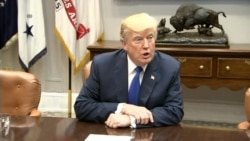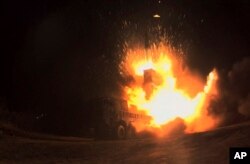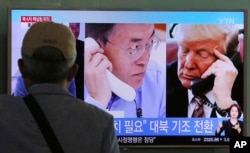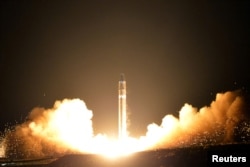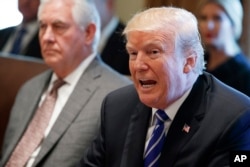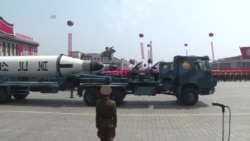North Korea's test-firing of a new intercontinental ballistic missile, the first since September, has ratcheted up tensions as Pyongyang announced it can now hit the United States mainland with a warhead.
"The newly developed intercontinental ballistic missile Hwasong-15 has been successfully test-launched according to the political decision and strategic judgement of the Workers' Party of Korea,” read an announcer Wednesday on North Korea’s state-run KRT television.
Following previous launches, the North has claimed its projectiles can hit any part of the continental United States, but this would be the first time it would be able to do so with this new type of upgraded missile, which both North Korean and U.S. officials said could fly higher than the ones the country has tested earlier.
North Korea “can hit US”
“The ICBM Hwasong-15 weapon system is an intercontinental ballistic rocket tipped with a super-large heavy warhead which is capable of striking the whole mainland of the U.S.," said a statement carried by North Korea’s KCNA news agency.
The statement said North Korean leader Kim Jong Un watched the launch and then “declared with pride that now we have finally realized the great historic cause of completing the state nuclear force, the cause of building a rocket power.”
It was not immediately clear if Pyongyang was claiming to have mastered the capability of miniaturizing and mounting a nuclear warhead on an ICBM, which South Korean officials have said could happen within a matter of months.
Analysts also question North Korea’s technical mastery of ICBM re-entry, which plays a key role in targeting. In the event of a launch at the U.S. mainland, U.S. missile defense systems would be employed.
Nonetheless, North Korea’s stepped-up threat was acknowledged by the United States and its allies, who vowed to increase pressure on Pyongyang.
“It went higher frankly than any previous shot they have taken,” said the U.S. Defense Secretary James Mattis. “It's a research and development effort on their part to continue building ballistic missiles that can threaten everywhere in the world basically.”
Allies respond
Commenting on the North’s missile test, U.S. President Donald Trump told reporters “we will take care of it.”
Trump did not elaborate but said there would be no change in the U.S. approach, which consists of “maximizing pressure” on North Korea and keeping all options on the table.
"Nothing changed. Nothing changed. We have a very serious approach. Nothing's changed. We take it very seriously,” added Trump.
WATCH: President responds to missile launch
South Korea responded to North Korea’s missile test within minutes, test-firing missiles of its own as a warning to Pyongyang of Seoul’s rapid and precision response capabilities.
Moon issued a stark warning to Pyongyang.
“We must prevent the possibility that North Korea may misjudge the situation and threaten us with its nukes or the United States may consider a preemptive strike,” Yonhap news quoted the president saying through his spokesman Moon Young-chan.
Moon said Pyongyang’s action endangered international peace and security.
“South Korea and the United States, along with the international community, have no other choice but to continue applying strong pressure and sanctions.”
Trump spoke separately by phone with Moon and Japanese Prime Minister Shinzo Abe to discuss Pyongyang’s ICBM test and how best to respond.
Abe called for an emergency meeting of the United Nations Security Council.
DPRK’s defiance
North Korea’s ICBM test came just a week after the U.S. tightened sanctions against Pyongyang and Trump returned it to the U.S.’s list of “state sponsors of terrorism,” which some analysts believe could explain the timing of the test.
“While it can be argued that the DPRK was likely to test an ICBM in any case, the timing of this launch was unusual,” said Frank Jannuzi, President and CEO of the Maureen and Mike Mansfield Foundation, in e-mailed comments to VOA. “DPRK missile testing is far more frequent in the spring than in the fall. I cannot help wondering whether Trump's exquisitely poor timing on the terrorism list issue hasn't squandered a chance to get dialogue started.”
Others argue Pyongyang wanted to demonstrate it would not bow to increased pressure.
“Kim wants us to believe that the new pressure from the U.S. and China has not had an impact. At a minimum, it looks like it forced him to launch at night fearing a preemptive strike,” said Georgetown University Assistant Professor Dennis Wilder, who was National Security Council senior director for East Asian affairs during the George W. Bush administration.
“That he launched in the middle of the night was interesting – perhaps fear of pre-emption,” agreed Atlantic Council Senior Fellow Robert Manning. “But getting spun up every time he acts is dumb, counter-productive and helps Kim’s victim-threat narrative, boosting him internally.
Trump’s hysterical, ridiculous tweets and taunting of Kim were key instigators in creating this pseudo-crisis atmosphere,” Manning adds.
“I would not blame or give credit to the president’s tweets,” countered David Maxwell, associate director of the Center for Security Studies at Georgetown University. “I do not think Kim Jong Un is ‘provoked’ by tweets. I think they conducted this test/strategic demonstration-not a provocation-for one or all of three reasons: A necessary test to advance the program, the regime believes it can gain some advantage in some way and domestic purposes in support of the military elite.”
The key question, according to Maxwell, who is a retired special forces colonel with multiple tours on the Korean peninsula, is what advantage does Kim think he might be obtaining with a launch at this time or is he really responding to China’s actions, international and U.S. sanctions, a 60-day "moratorium," or something else? And the second key question, he added, is how should the United States respond?
WATCH: How people reacted to Pyongyang's latest missile launch
Nuclear deterrence
North Korea tested less powerful ICBMs in July and its sixth, and most powerful, nuclear device in September. Pyongyang says its nuclear and missile programs act as a strong deterrent to prevent an attack from the U.S., while analysts say the alleged U.S. threat is used by North Korea to maintain power over its people since fighting in the Korean War ended.
Regardless of nuclear arms, all agree a return to war on the Korean peninsula would be devastating as the area around Seoul, which is within North Korea's artillery range and home to half of South Korea's population. South Korea and Japan have U.S. military bases while China and Russia share borders with North Korea.
“I think that all actors are deterred and the constraints are robust and real,” says Troy University in Seoul analyst Daniel Pinkston. “And any unilateral military action by any actor in Northeast Asia to change the status quo militarily would fail miserably. That includes North Korea and all the other actors and stakeholders including the U.S. and China, Japan and South Korea, Russia. So, we’re kind of stuck in this sub-optimal equilibrium. Everyone is dissatisfied and doesn’t like it,” added Pinkston.
While tougher sanctions are on the horizon - raising the costs for Pyongyang's defiance - many question whether it can be pressured into giving up its nuclear and missile programs.
“These capabilities are not something that can be negotiated away,” says Pinkston. It’s part of their identity, it’s part of their national security policy. They view all of the U.N. Security Council resolutions prohibiting these activities as illegitimate and they will continue to challenge those U.N. Security Council resolutions and challenge the international community.”
But, Pinkston said the good news is that we have a lot of experience with deterrence. “We did it against a much more menacing adversary in the Soviet Union during the Cold War, we have much greater capabilities and resources and alliance partners and everything else. So, there’s no need to panic.”







